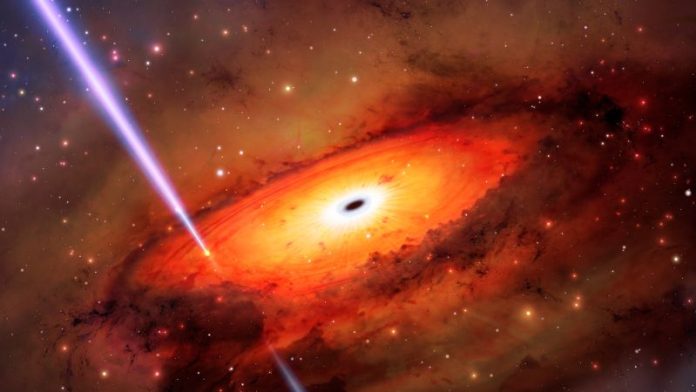
Have you ever wondered what happens when stars collide?
A group of international space scientists think they’ve figured out an exciting new answer.
Usually, bursts of powerful light, known as gamma-ray bursts, come from massive stars exploding or neutron stars crashing together.
But a recent study points to a new source for these bursts: stars smashing into each other near a supermassive black hole.
This stellar smash-up, in the heart of an ancient galaxy, might be another way that stars can be destroyed, creating gamma-ray bursts in the process.
“This gives us a new way to think about how stars end their lives, and could help us understand other cosmic mysteries, like what else might create gravitational waves that we can detect on Earth,” said the team.
The research, led by Radboud University in the Netherlands and including astronomers from Northwestern University, was partly funded by the U.S. National Science Foundation.
Their findings were published in the journal Nature Astronomy.
“We see lots of gamma-ray bursts that we can easily explain, but there’s always that one in a hundred that surprises us,” said Wen-fai Fong, a Northwestern astrophysicist and a co-author of the study. “It’s these unexpected ones that teach us the most about the variety of explosions in the universe.”
Another Northwestern astrophysicist and co-author of the study, Giacomo Fragione, added, “This amazing discovery gives us a sneak peek into the complex dynamics happening in these cosmic environments. It’s like finding a factory that makes things we thought were impossible.”
Stars usually die in one of three predictable ways. Stars like our sun shed their outer layers as they get old, and eventually become white dwarf stars. Bigger stars burn brighter and faster, and explode into supernovae, creating super dense objects like neutron stars and black holes. The third scenario is when two of these dense remnants form a pair and crash into each other.
But now, the scientists think there might be a fourth way for stars to meet their end.
“We’ve found that stars can also die in the busiest parts of the universe, where they can be forced to collide,” said lead author Andrew Levan, an astronomer with Radboud University. “This is fascinating for understanding how stars die and for helping us answer other questions, like what else might create gravitational waves that we can detect on Earth.”
On October 19, 2019, NASA’s Neil Gehrels Swift Observatory saw a bright flash of gamma rays that lasted just over a minute. These long-lasting bursts usually come from stars collapsing that are at least 10 times the mass of our sun.
Using the Gemini South Telescope in Chile, the researchers were able to study the burst’s afterglow as it faded.
The researchers hope that by studying more of these events, they can match a gamma-ray burst with detection of gravitational waves, revealing more about their nature and origins.
They’re excited about the launch of the Vera C. Rubin Observatory in 2025, which will be a big help in this type of research.
Follow us on Twitter for more articles about this topic.



